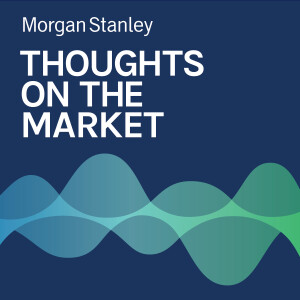
Matthew Hornbach: The Return of Government Bonds
 2023-04-27
2023-04-27
While government bonds have been less than desirable investments for the past two years, the tide may be turning on bond returns.
----- Transcript -----
Welcome to Thoughts on the Market. I'm Matthew Hornbach, Global Head of Macro Strategy for Morgan Stanley. Along with my colleagues, bringing you a variety of perspectives, I'll be talking about global macro trends and how investors can interpret these trends for rates and currency markets. It's Thursday, April 27th at 2 p.m. in New York.
Over the past 2 years, government bonds have been less than desirable investments. This year, the inflation phenomena came out of hibernation and appears unwilling to go away anytime soon.
In 2022, one of the worst years on record, U.S. Treasuries delivered a total return of -12.5%. Securities that offer fixed interest payments like government bonds tend to lose value when inflation rises, because the future purchasing power of those cash flows declines. But that doesn't always happen, of course, and certainly not to this degree.
For most of the past 20 years, government bonds dealt reasonably well with positive inflation rates, even if those rates were rising. But last year was different, for two reasons primarily. First, inflation rose at a rate we haven't seen since the late 1970s. And second, central banks responded aggressively by tightening monetary policies.
How have these factors changed so far this year? Well, inflation has started to moderate both in terms of consumer prices and wages. And in response, central banks have become less aggressive in their recent policy maneuvering. Investors have also benefited from the clarity on the speed with which central banks have moved and how fast they may move in the future. This would seem like good news for government bond returns, and so far it has been. However, at the same time, investor nerves remain frayed, even if less so than last year. But why?
First, investors remain worried about inflation, but for different reasons than last year. Throughout 2022 concern focused on the speed with which inflation was rising and just how high it would go. This year, however, concerns remain around how far inflation will fall, a process known as disinflation.
The consensus view amongst investors is that inflation will remain above the Fed's 2% goal unless the Fed engineers a deep recession. And to do so, the Fed will either have to tighten monetary policy even further or keep monetary policy tight for an extended period of time. Neither scenario seems particularly supportive of government bond returns.
Second, investors are worried about the upcoming debt ceiling negotiations. The concern isn't so much that the government will default on its debt obligations, although that is a possibility. Rather, it's more about whether the government will have to delay paying other obligations, such as federal employee salaries or Social Security. A cessation of those payments, even if temporary, could slow economic activity in the United States. And even if the debt ceiling is raised in time, material risks to regional banking institutions still remain.
Putting it all together, the higher yields available in the government bond markets and the increasing risk to economic activity, including those from the lagged effects of monetary policy tightening, leave us hopeful on the future returns of the asset class.
Thanks for listening. If you enjoy Thoughts on the Market, please take a moment to rate and review us on the Apple Podcasts app. It helps more people find the show.
More Episodes
 2024-11-15
2024-11-15
 2024-11-14
2024-11-14
 2024-11-13
2024-11-13
 2024-11-12
2024-11-12
 2024-11-11
2024-11-11
 2024-11-08
2024-11-08
 2024-11-07
2024-11-07
 2024-11-05
2024-11-05
 2024-11-01
2024-11-01
 2024-10-31
2024-10-31
 2024-10-30
2024-10-30
 2024-10-29
2024-10-29
 2024-10-28
2024-10-28
 2024-10-25
2024-10-25
 2024-10-23
2024-10-23
Create your
podcast in
minutes
- Full-featured podcast site
- Unlimited storage and bandwidth
- Comprehensive podcast stats
- Distribute to Apple Podcasts, Spotify, and more
- Make money with your podcast
It is Free
- Privacy Policy
- Cookie Policy
- Terms of Use
- Consent Preferences
- Copyright © 2015-2024 Podbean.com




